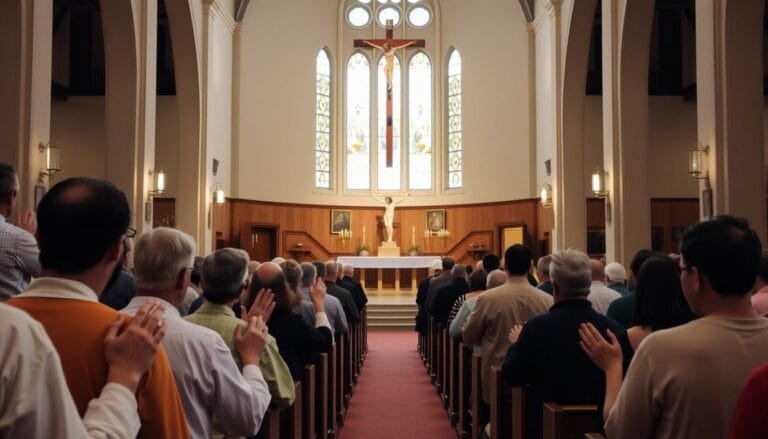Understanding The Catholic Bible
This website contains affiliate links. As an Amazon Associate, I earn from qualifying purchases. The content on this website was created with the help of AI.
The Catholic Bible has 73 books, while the King James Version has 66. This difference sets Catholic and Protestant scriptures apart.
It’s a starting point for exploring the Catholic Bible’s unique aspects.
The Catholic Bible is vital to our faith. It offers sacred texts that guide our spiritual journey. Its wisdom shapes Church teachings and provides a foundation for Scripture interpretation.
Reading these sacred texts daily can transform our connection with God. The Bible in a Year podcast by Fr. Mike Schmitz has become popular.
It guides believers through the entire Catholic Bible in 365 episodes.
This podcast has rekindled passion for God’s Word among many faithful. It offers an innovative approach to studying Scripture. Many find it helpful in their spiritual journey.
Let’s explore the Catholic Bible’s historical roots and unique features. We’ll discover how it shapes our faith today.
This journey through sacred history and divine revelation promises to be enlightening.
Key Takeaways
- The Catholic Bible contains 73 books, including 7 deuterocanonical texts
- Daily Scripture reading is crucial for spiritual growth and deepening faith
- The Bible in a Year podcast offers a guided journey through the entire Bible
- Understanding the Catholic Bible enhances prayer life and provides spiritual guidance
- The Catholic Bible’s unique features reflect its rich historical and theological background
The Historical Foundation of the Catholic Bible
The Catholic Bible has deep roots in Church history. We’ll explore its journey from ancient times to today. Key milestones have shaped this sacred text over centuries.
Origins and Development Through Church History
The Catholic Bible’s story begins with the Septuagint, a Greek translation of Hebrew scriptures. Early Christians used this version, which became the basis for the Old Testament.
Over time, various translations emerged. Each one added to the rich tapestry of biblical tradition.
The Council of Trent’s Role in Canon Formation
In 1546, the Council of Trent shaped the Catholic Bible. It included deuterocanonical books, setting the Catholic canon apart from Protestant versions.
This decision created the 73-book structure we know today. It solidified the unique content of the Catholic Bible.
Evolution from the Latin Vulgate to Modern Translations
St. Jerome’s Latin Vulgate was the main source of Catholic translations for centuries. As language changed, so did Bible translations.
Modern versions like the New American Bible aim for balance. They combine accuracy with current language while keeping Catholic biblical interpretation intact.
| Era | Key Development | The standard text for centuries |
|---|---|---|
| 3rd-1st century BC | Septuagint translation | Basis for Old Testament |
| 4th century AD | Latin Vulgate | Accessible language preserved tradition |
| 1546 | Council of Trent | Canon formation |
| 20th-21st century | Modern translations | Accessible language, preserved tradition |
The Catholic Bible’s evolution shows the Church’s dedication to sacred scripture. It strives to keep tradition while making the Bible accessible to all believers.
Understanding The Catholic Bible’s Unique Features
The Catholic Bible has distinct characteristics that reflect the rich Catholic tradition. It offers unique and valuable insights for believers.
The Significance of 73 Books
The Catholic Bible’s comprehensive Catholic canon is a standout feature. It contains 73 books: 46 in the Old Testament and 27 in the New Testament.
This expanded collection provides a broader view of biblical history and teachings. It offers readers a more complete understanding of the faith.
Exploring the Deuterocanonical Books
Seven deuterocanonical books are included in the Catholic Bible. These are also known as the Apocrypha in some traditions.
The texts include Tobit, Judith, 1 and 2 Maccabees, Wisdom, Sirach, and Baruch. They offer insights into Jewish history and beliefs during the intertestamental period.
Catholic Bible Translation Methodologies
Catholic Bible translations balance accuracy and readability. Translators use both literal and dynamic equivalence approaches.
This method conveys the original meaning while keeping the text accessible. It helps modern readers understand the scriptures more easily.
| Translation Approach | Focus | Example |
|---|---|---|
| Literal | Word-for-word accuracy | Revised Standard Version Catholic Edition |
| Dynamic Equivalence | Thought-for-thought clarity | New American Bible Revised Edition |
| Balanced | Combines literal and dynamic approaches | Jerusalem Bible |
These unique features help Catholics better understand their sacred text. They provide a deeper connection to the faith’s rich history and teachings.
Daily Scripture Reading and Spiritual Growth
Daily Bible reading is vital for Catholic spiritual growth. It deepens our faith and enhances our prayer life.
Regular scripture engagement offers insights and nourishment, bringing us closer to God.
- The Bible in a Year Companion: Volume I

Structured approaches to daily scripture reading can be helpful. Fr. Mike Schmitz’s Bible in a Year podcast is a great example. It guides listeners through the entire Bible in 365 days.
This method helps us understand salvation history better. It also shows us how to apply scriptural teachings to our lives.

Various tools can support our faith formation journey. The BibleOn App offers multilingual text and audio Bibles, including Catholic editions.
It’s free, ad-free, and allows offline reading or listening.
This app is perfect for daily Catholic Bible study. You can download entire Bible books for easy access.
“The Word became flesh and made his dwelling among us. We have seen his glory, the glory of the one and only Son, who came from the Father, full of grace and truth.” – John 1:14
Daily scripture reading boosts our spiritual growth in many ways:
| Aspect | Benefit | Scripture Example |
|---|---|---|
| Faith Formation | Deepens understanding of God’s love | John 3:16 |
| Prayer Life | Enhances communication with God | Psalm 33:6 |
| Spiritual Development | Fosters personal growth | 2 Peter 1:4 |
| Wisdom | Provides guidance for daily life | Proverbs 3:19 |
Regular Bible reading helps build a rich spiritual life. It grounds us in scripture and strengthens our faith. Consistency is key in this journey of faith formation.
Essential Tools for Catholic Bible Study
Catholic Bible study can be deeply enriching. Here’s a list of valuable resources to enhance your scriptural exploration.
Recommended Catholic Bible Editions
Catholic study Bibles offer various translations. The New American Bible Revised Edition (NABRE) features a comprehensive 525-page Scripture introduction.
The Revised Standard Version Catholic Edition (RSV2CE) includes the Didache Study Bible with over 100 apologetic essays.
The New Jerusalem Bible provides modern critical scholarship notes for the Old Testament.
Digital Resources and Study Apps
Bible apps have transformed Scripture access. Logos, Verbum, and Olive Tree offer electronic editions of Catholic study Bibles.
- Jeff Cavins
- Dr. Mary Healy
- Dr. Andrew Swafford
These platforms provide features like cross-referencing and commentary integration. They make Bible study more accessible and interactive for users.

Catholic Bible Study Guides and Commentaries
Study guides and commentaries deepen our understanding of Scripture. The Catechism of the Catholic Church serves as a crucial reference.
Scott Hahn’s Ignatius Catholic Study Bible features insightful notes. The St. Paul Center offers free online Bible studies and reflections on Sunday Mass readings.
| Resource Type | Examples | Features |
|---|---|---|
| Study Bibles | NABRE, RSV2CE, NJB | Introductions, essays, notes |
| Digital Apps | Logos, Verbum, Olive Tree | Cross-referencing, commentary integration |
| Study Guides | Catechism, Ignatius Study Bible | In-depth analysis, Church teachings |
These tools help us explore Catholic Scripture more deeply. They offer valuable insights into our faith and enhance our understanding.
Conclusion
The Catholic Bible is a rich tapestry of faith and wisdom. It offers 73 books of spiritual guidance. This sacred text deepens our faith and nurtures our spiritual journey.
The Church’s commitment to Scripture is long-standing. Since the 4th century, the Bible has been central to Catholic life. Today, priests spend about 90 minutes daily in scriptural prayer.
Engaging with the Catholic Bible is more than a scholarly pursuit. It’s a living, breathing part of our faith. The Scriptures offer endless opportunities for growth.
Through daily readings or quiet reflection, we can connect with God. This divine gift helps us understand our Catholic faith better. Let’s embrace the Bible and deepen our spiritual lives.











